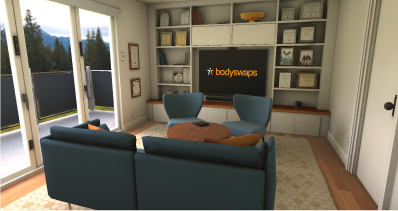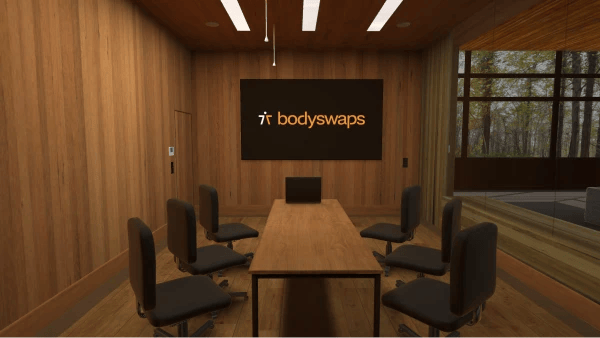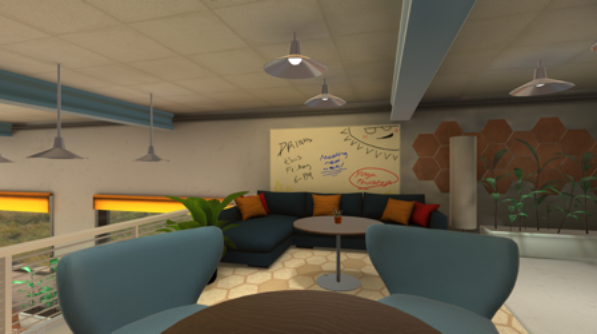Talented Teamwork
Tutor Notes
Talented Teamwork is an immersive training module designed to build the skills that will help individuals work well with others in the workplace. Coached activities include understanding different team player styles and behaviours that help to strengthen collaborative relationships.
About this resource
Key learner outcome and goals
Learning Outcome
Recognise how effective teamwork is essential for a happy, productive, enjoyable work life.
Learning Goals
- Identify what kind of team player you are
- Explore team busting or boosting behaviours
- Collaborating with others
- Demonstrate how to be an effective team player
A word about terminology
As a medium, Virtual Reality is not best suited to didactic teaching methods. However, our intention is that all Bodyswaps modules follow a student-centred constructivist pedagogy. This means creating rich experiences in which learners can explore key concepts and ideas and reach their own conclusions. This is why our documents speak in terms of learning goals and outcomes, rather than measurable ‘learning objectives’ (a la Bloom’s Taxonomy) per se.
Module structure
The complete journey takes the learner through 4 interactive topics, led by virtual mentors Nola and Leo, as well as ancillary activities such as onboarding, self-reflection, and the exit survey.
It is a linear experience, meaning the learner will be guided step by step through all the activities by the virtual coaches.
We recommend that learners fully interact with each activity to get the full benefit.
It is estimated that each topic will take the learner approximately 5-10 minutes to complete, although completion times vary depending on whether the learner chooses to repeat topics to explore different options (encouraged) or fine-tune their freeform responses.
Learner Journey
.svg)
.svg)
- Sticky diagnostic
- Freeform
.svg)
.svg)
conversation
.svg)
.svg)
.svg)
.svg)
Characters
Virtual Mentors
.webp?width=720&height=1050&name=leo%20(4).webp)
.webp?width=720&height=1050&name=nola%20(1).webp)
Nola
Team Members
.webp?width=720&height=1050&name=james%20(2).webp)
James
.webp?width=720&height=1050&name=astrid%20(1).webp)
Astrid
.webp?width=720&height=1050&name=suki%20(1).webp)
Suki
.webp?width=720&height=1050&name=jamal%20(2).webp)
Jamal
Learning Environments

Tutor Room - Bodyswaps HQ

Boardroom at Mindfire, a leading marketing agency

Mindfire's breakout/coffee room
Purpose
Familiarise learners with the controls and navigation
Location
Characters
N/A
Duration
3:00
The first time learners use Bodyswaps, this onboarding sequence familiarises them with the features of the app, takes them through an avatar selection and embodiment activity, and prepares them for the experience to come.
In the onboarding, learners will:
- Find out how this training is different from the rest
- Select their avatar
- Discover their virtual journal
- Learn how to navigate and use the tools and settings
Purpose
Introduce the module and reflect on current confidence levels before beginning the activities
Location
Characters
Journal
Duration
The module opens with the virtual mentors, Leo and Nola, congratulating the learner on landing a job at Mindfire, a leading marketing agency.
The learner's task is to join the new team developing the promotional campaign for a 'hackathon' event hosted by Mindfire's biggest client, the Academy of Ideas and Imagination.
This training will help the learner grow their teamwork talents and become a valued member of the team.
Before the training begins, the learner is invited to complete a short likert-style self-reflection survey, to indicate how confident they feel about the following key learning points:
- Understanding their team player style
- Exploring behaviours that bust team spirit
- Collaborating with others
- Demonstrating how to be an effective team player
These self-reflection questions will be repeated in the debrief at the end, to assess how the learner’s confidence levels have changed.
Note: If you wish to receive data about how the learner’s confidence levels have changed as a consequence of the training, it’s important that they complete this introduction and the debrief at the end.
Purpose
Help learners reflect on their primary team player style
Location
Characters
Nola and Leo, virtual mentors Suki, James, Astrid and Jamal – virtual teammates
Duration
Teamwork is about individuals actively working together as a team, so this diagnostic activity - inspired by the Parker Team Player Survey - is designed to help the learner reflect on what kind of team player they are, and what qualities and characteristics they might bring to a group.
The learner is introduced to each of their virtual teammates before answering six questions to determine their natural team player style as:
- Collaborator
- Contributor
- Communicator
- Challenger
- Combo (mix of the above)
An on-screen visual reveals which team player style each chosen response reflects. Once the learner has answered all the questions, Nola and Leo provide feedback on the team player style they most identify with. The learner can also learn more about the other team player styles.
Following this activity, the learner is encouraged to think about their own real life teamwork experiences, and describe in their own words, a time when they were involved in a team task and how their actions represented one of the four types of team player.
Purpose
Identify negative team player behaviours in a team dynamic
Location
- Intro: Tutor room
- Observation: Board room
Characters
Intro: Nola and Leo, virtual mentors Observation: Suki, James, Jamal, Astrid
Journal
Duration
It takes great people skills to be a good team player, but nothing busts the team spirit mood like a Negative Nancy or a Pessimist Pete!
In this observation activity the learner sits in on a meeting with their teammates and watches out for examples of buzz-killing behaviour.
Negative team player behaviours include:
- Being critical without solutions
- Being disrespectful
- Self-promoting
- Talking without listening
- Not focusing on goals
Visual feedback is provided in real time to indicate if a learner has correctly identified a behaviour. Summary feedback is supplied at the end of the animation, with a panel of buttons indicating which events were identified.
Clicking on a button rewinds the conversation to the corresponding instance for the learner to rewatch. Then, text feedback explains why the behaviour had a negative impact on the team.
Purpose
Use emotional intelligence to discuss with an open mind
Location
(New) breakout room area
Characters
Leo and Nola, Astrid and Jamal
Journal
Duration
The marketing campaign for the Academy's hackathon is now underway, and the learner is invited to collaborate with the Mindfire team to develop a concept for the promotional material.
When working with others, it's important that everyone feels heard and their input is valued, so in this scaffolded conversation activity the learner puts their collaboration skills to the test. This means they'll need to strike a balance between listening to their teammates and actively contributing to the discussion, by either offering up their own suggestions or building on the ideas of others.
The learner chooses what to say from three given options, each of which elicits a different response from their teammates. A pop-up also provides additional information about the impact of what they said.
In real life, collaborating effectively can be hard because sometimes, when people are trying to get along, they hide how they really feel. So in this simulation, each time a teammate responds, the learner also gets to see what they're really thinking.
By selecting the 'right' answer at each stage, the discussion will unfold positively between the learner and their teammates, and their collaborative spirit will be strengthened. It's also a chance for the learner to try out different responses if they choose the ‘wrong’ one – and see the various turns the conversation can take!
Purpose
Practise being an effective team player
Location
Intro – Upstairs in the breakout area
Downstairs in the breakout area
Characters
Nola and Leo (intro and end only) – sitting upstairs
Suki, Astrid, James and Jamal - sitting downstairs
Journal
Duration
The hackathon has now taken place and was such a success, the Academy has already asked Mindfire to start planning another one for the following year.
In this freeform conversation activity, the team is meeting up to discuss ideas about how to grow and improve on the event. The learner's goal is to collaborate with their teammates by contributing to the discussion and practise applying some of the skills they've picked up during the training.
As the learner responds to their teammates, speaking aloud in their own words, LLM AI evaluates whether they’re demonstrating effective or ineffective collaboration, and the rest of the Mindfire team responds accordingly.
If the learner is unsure of what to say, they are presented with three scaffolded conversation-type options to help them move the conversation forwards to the next exchange.
The learner also receives some helpful feedback on key elements of effective collaboration, including body language, eye contact, hand gestures, speaking pace and tone.
The mentors conclude the activity by offering some closing pointers on how well the learner performed the task.
Purpose
Debrief the learner upon completion of the training and prompt self-reflection
Location
Tutor room
Characters
Nola and Leo
Journal
N/A
Duration
The key function of the debrief activity is to invite the leaner to take the same likert-style survey from the beginning, to encourage them to reflect and self-report on their confidence levels following completion of the training.
The questions relate to how confident they feel about the key learning points:
- Understanding their team player style
- Exploring behaviours that bust team spirit
- Collaborating with others
- Demonstrating how to be an effective team player
Purpose
Assess the effectiveness of the training itself
Location
Tutor room
Characters
Nola and Leo
Journal
N/A
Duration
Before the learner leaves the module, they are asked to complete a short survey about their experience.
This survey is not compulsory, but the data helps us to assess the effectiveness of our product and identify any areas that need improvement. Clients also find it beneficial when assessing ROI.
They are asked to mark whether they agree or disagree with the following statements, on a 10 point scale:
- I would recommend this experience to others
- The experience helped me identify elements I could improve upon
- I have a better understanding of how to be an effective team player
